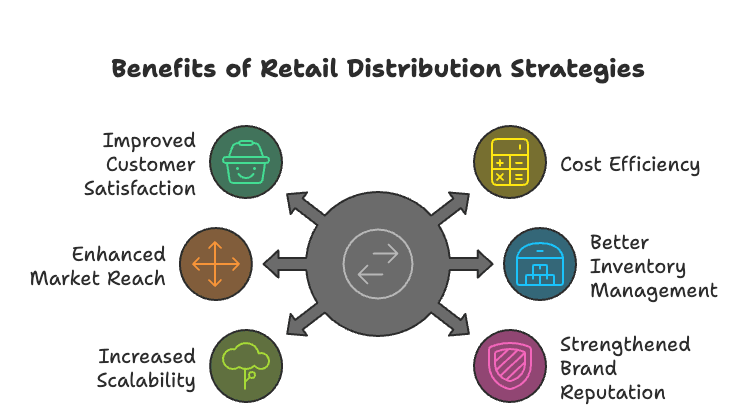Imagine running an e-commerce business without a distribution strategy. Whether you are a retailer or a wholesaler, distribution is one critical aspect that requires careful planning. How much sales you make depends on how effective your distribution is in the long term. A retail strategy includes the effective distribution. It is a process management that engages in monitoring the whole movement of products between the suppliers and the final consumers making sure that they deliver in good time and coordinate effectively in the channels used.
But how should you create a solid strategy? In this blog, we will explore the dynamics of retail distribution, how it works, and its benefits.

What is Retail Distribution?
It is the process of transferring goods from manufacturers or suppliers to end consumers through various channels. These channels may include wholesalers, distributors, online platforms, or directly to retailers. A solid strategy considers logistics, inventory management, cost-efficiency, and customer satisfaction, ensuring that the right product reaches the right customer at the right time.
You understand the importance of distribution in the retail industry. Next, let’s delve into the best practices to create a distribution channel.
Best Practices for Developing a Retail Distribution Strategy
Integrating various distribution channels extends the reach of products and helps you target a wider customer base. Here are the best practices you should follow in 2024:
1) Understand Your Target Market
Before developing a distribution plan, it’s crucial to understand your target market. Analyse your customers’ preferences, purchasing behaviours, and expectations. If you cater to a niche market or have customers in multiple regions, your retail distribution strategy may require diversification to meet different needs.
2) Choose the Right Distribution Channels
Direct store distribution allows manufacturers to deliver products straight to retail outlets, reducing intermediaries and speeding up replenishment. There are several distribution channels to consider, and selecting the right one depends on your business model and market demands. Partnering with online distributors can expand your reach to digital marketplaces and help tap into broader customer bases. Common retail distribution channels include:
- Direct-to-Consumer (D2C): Selling directly to customers through a company’s website or stores. This gives you more control over pricing, branding, and customer experience.
- Retailers: Selling products through brick-and-mortar retailers or e-commerce platforms like Amazon. This method helps you reach a broader audience but often results in lower margins.
- Wholesalers: Partnering with wholesalers who distribute your products to various retailers. This can increase your reach but may involve less control over your brand positioning.
- Hybrid Models: A combination of multiple channels like D2C and third-party retailers. This approach provides flexibility but requires careful management to avoid conflicts between channels.
3) Leverage Technology for Inventory Management
Efficient inventory management is a cornerstone of a solid retail distribution strategy. Implementing systems such as Enterprise Resource Planning (ERP) or Warehouse Management Systems (WMS) can help track stock levels in real time, optimise warehouse operations, and avoid stockouts or overstocking issues. This creates a sustainable supply chain ecosystem for all industry stakeholders.
4) Optimize Logistics and Supply Chain Management
Your retail sales distribution strategy must prioritise efficient logistics. This includes planning for warehousing, transportation, and last-mile delivery. Partnering with third-party logistics (3PL) providers can streamline operations, helping you cut costs and reduce shipping times. Additionally, consider strategies like cross-docking to reduce handling times or utilising regional fulfilment centres to improve delivery speed. An effective retail distribution warehouse is crucial for managing inventory efficiently and ensuring timely order fulfillment.
5) Build Strong Relationships with Partners
Whether working with wholesalers, distributors, or retailers, maintaining strong relationships is key to ensuring a smooth retail distribution process. Clear communication, transparency, and mutual benefit are important to establish long-lasting partnerships. This ensures your product moves efficiently through the supply chain without unnecessary delays.
6) Monitor Key Metrics and Continuously Improve
A successful retail distribution strategy is not static. Continuously monitor key performance indicators (KPIs) like order fulfilment rates, lead times, inventory turnover, and delivery accuracy. Use these insights to identify bottlenecks or inefficiencies and adapt your strategy accordingly. Regularly evaluating your distribution performance ensures that your strategy evolves with changing market conditions.
7) Focus on Customer Experience
Customer satisfaction is directly impacted by your retail distribution strategy. Fast, reliable shipping, accurate order fulfilment, and easy returns are just a few factors that can enhance the customer experience. Consider offering multiple delivery options, such as express or next-day delivery, and ensure your return policy is hassle-free.
Now, let’s take a closer look at the benefits of an effective distribution strategy.
Benefits of a Solid Retail Distribution Strategy
In today’s dynamic retail landscape, using multi-level product distribution strategies helps you stay ahead of competition. Here are a few benefits listed below:

1) Improved Customer Satisfaction
A well-organized retail distribution strategy ensures that customers receive their products on time and in good condition. Whether you’re using direct or indirect channels, prioritizing fast and accurate deliveries leads to higher customer satisfaction and repeat business.
2) Cost Efficiency
Optimising retail distribution means reducing unnecessary expenses. By implementing efficient logistics, automating inventory management, and selecting the right distribution partners, you can minimize shipping costs, warehousing fees, and labour expenses. Total distribution management will reduce costs as well as coordination among various channels, which will give greater control over product flow and inventory levels.
3) Enhanced Market Reach
Choosing the right intensive distribution strategy allows businesses to reach a wider audience. Selling through established retailers or e-commerce platforms exposes your brand to new customer bases that may not have been accessible otherwise. In contrast, a direct-to-consumer approach gives you control over branding and customer relationships while also expanding your reach.
4) Better Inventory Management
With advanced tools and technology, a strategy can improve inventory management, reducing the risk of stockouts and excess inventory. Real-time tracking and predictive analytics allow businesses to balance supply and demand more effectively, improving operational efficiency.
5) Increased Scalability
A scalable strategy allows you to adapt to changing business needs, such as seasonal demand spikes or new product launches. By streamlining operations and building strong partnerships, your distribution network can grow along with your business, ensuring you can handle larger order volumes without compromising quality or delivery speed.
6) Strengthened Brand Reputation
Effective distribution reflects positively on your brand. When customers consistently receive their products on time, intact, and with a positive overall experience, your brand reputation grows stronger. In the long term, this can lead to increased loyalty, positive reviews, and greater word-of-mouth promotion.
Finally, let’s tackle the FAQs section of the blog.
Conclusion
Supply chain management is a complex web of retailers, vendors, and stakeholders, optimising the distribution of products across the globe. Needless to say, when choosing a retail distribution strategy, understand the best practices of each potential channel. Do you need help to get started? Contact Qodenext today for an in-depth guide on supply chain and logistics management.
FAQs: Retail Distribution
1. What are the most common retail distribution methods?
The most common distribution channels include direct-to-consumer (D2C), retailers (both online and physical stores), wholesalers, and hybrid models. Each offers unique benefits depending on your business model and target market.
2. How can I improve my retail distribution strategy?
To improve your retail distribution strategy, focus on understanding your target market, selecting the right channels, optimising logistics, and utilising technology for better inventory management. Regularly monitor KPIs and adapt your strategy as necessary.
3. Why is inventory management important in retail distribution?
Efficient inventory management prevents stockouts and overstocking, ensuring that products are available when customers need them. It also reduces warehousing and logistics costs, contributing to a more cost-effective retail strategy.
4. What role does technology play in retail distribution?
Technology plays a crucial role in modern retail processes by automating processes, providing real-time insights into inventory levels, optimising logistics, and improving customer experience through faster delivery times and smoother returns.
5. How does a retail distribution strategy impact customer satisfaction?
A well-executed distribution ensures timely, accurate deliveries and smooth customer experiences, from order placement to returns. This enhances customer satisfaction, builds loyalty, and can lead to repeat purchases.
6. What are the main types of retail distribution strategies?
The three primary types are intensive, selective, and exclusive distribution, each chosen based on product type and market goals.
7. How can a business choose the right strategy?
Choose based on your product pricing, target audience, and desired brand positioning for optimum visibility and profitability.
8. How does technology improve retail distribution?
Automation, AI, and analytics streamline inventory management, enhance forecasting, and reduce delivery delays.
9. What are the challenges in retail distribution?
Common issues include inventory mismanagement, high logistics costs, and inconsistent partner performance.
10. What are best practices for a solid retail distribution strategy?
Focus on customer demand, build strong logistics partnerships, and use multi-channel distribution for broader reach.






